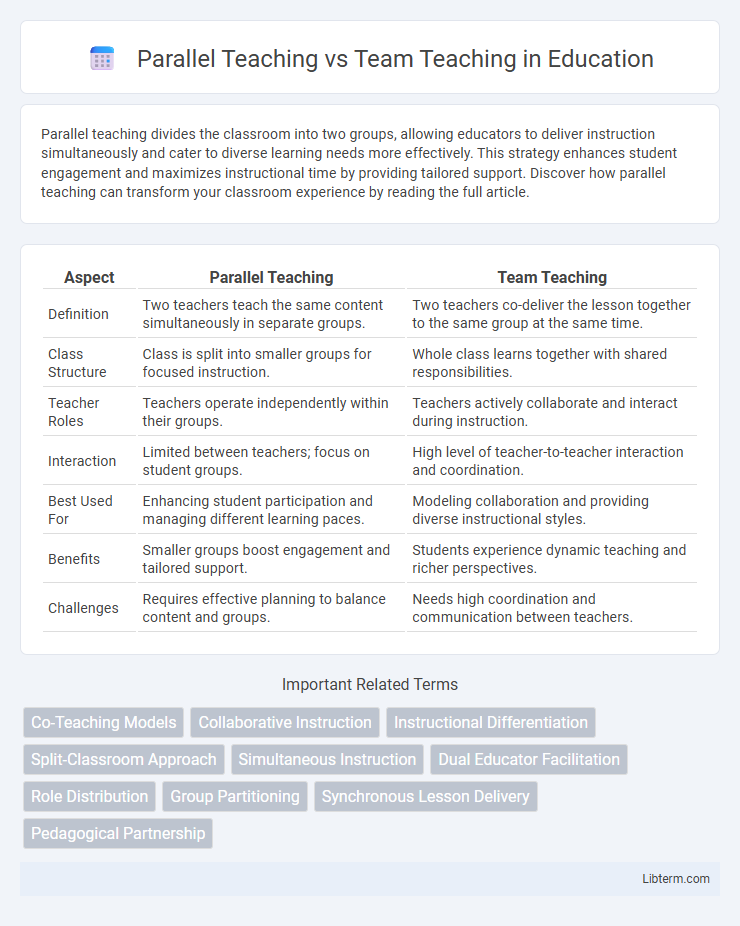Parallel teaching divides the classroom into two groups, allowing educators to deliver instruction simultaneously and cater to diverse learning needs more effectively. This strategy enhances student engagement and maximizes instructional time by providing tailored support. Discover how parallel teaching can transform your classroom experience by reading the full article.
Table of Comparison
| Aspect | Parallel Teaching | Team Teaching |
|---|---|---|
| Definition | Two teachers teach the same content simultaneously in separate groups. | Two teachers co-deliver the lesson together to the same group at the same time. |
| Class Structure | Class is split into smaller groups for focused instruction. | Whole class learns together with shared responsibilities. |
| Teacher Roles | Teachers operate independently within their groups. | Teachers actively collaborate and interact during instruction. |
| Interaction | Limited between teachers; focus on student groups. | High level of teacher-to-teacher interaction and coordination. |
| Best Used For | Enhancing student participation and managing different learning paces. | Modeling collaboration and providing diverse instructional styles. |
| Benefits | Smaller groups boost engagement and tailored support. | Students experience dynamic teaching and richer perspectives. |
| Challenges | Requires effective planning to balance content and groups. | Needs high coordination and communication between teachers. |
Introduction to Parallel Teaching and Team Teaching
Parallel Teaching involves two educators simultaneously instructing different groups of students within the same classroom, allowing for smaller group sizes and more personalized attention. Team Teaching, also known as co-teaching, features two teachers collaboratively delivering the same lesson to all students, blending their expertise to enhance learning through shared responsibilities. Both models optimize classroom dynamics but differ in structure and instructional approach.
Definitions and Core Concepts
Parallel teaching involves two educators dividing a class into smaller groups to teach the same content simultaneously, enhancing student engagement and allowing for targeted instruction. Team teaching, also known as co-teaching, features both teachers delivering instruction together in the same classroom, blending their expertise to provide diverse perspectives and collaborative support. These approaches differ primarily in group structure and teacher collaboration, with parallel teaching emphasizing simultaneous separate delivery and team teaching focusing on joint, integrated instruction.
Structure and Classroom Dynamics
Parallel Teaching divides the class into smaller groups, allowing two teachers to simultaneously deliver the same lesson, which enhances individualized attention and active participation. Team Teaching involves both educators sharing instructional responsibilities simultaneously, engaging in a dynamic interaction that models collaborative learning and diverse teaching styles. Classroom dynamics in Parallel Teaching lean towards focused, smaller group interactions, while Team Teaching fosters a more unified and interactive environment through continuous collaboration.
Teacher Roles and Responsibilities
In parallel teaching, teachers split the class into two groups and deliver instruction simultaneously, allowing for smaller group sizes and more individualized attention. Each teacher independently manages lesson delivery, behavioral expectations, and assessment within their group, emphasizing distinct roles in content presentation and classroom management. Team teaching involves both educators collaboratively planning, presenting, and assessing the same lesson simultaneously, sharing equal responsibility in instruction, student engagement, and adapting teaching strategies to meet diverse learner needs.
Student Engagement and Participation
Parallel Teaching divides a class into smaller groups with two instructors simultaneously teaching the same material, increasing student engagement by allowing more individualized attention and active participation. Team Teaching involves both instructors collaboratively delivering the lesson to the entire class, fostering dynamic interactions and diverse perspectives that enhance student participation. Both methods boost engagement, but Parallel Teaching offers more personalized interaction, while Team Teaching emphasizes collaborative learning experiences.
Advantages of Parallel Teaching
Parallel teaching enhances student engagement by allowing smaller group instruction, which facilitates more personalized attention and tailored lesson pacing. It increases instructional time by enabling simultaneous delivery of content, leading to greater coverage and reinforcement of material. This approach also supports differentiated learning styles, helping educators address diverse student needs more effectively within the same classroom environment.
Benefits of Team Teaching
Team teaching enhances student engagement by combining diverse expertise and teaching styles within the classroom, fostering a collaborative learning environment. It allows for immediate feedback and support, as instructors share responsibilities and adapt dynamically to student needs. This approach improves instructional quality and promotes professional development through continuous teacher interaction and shared best practices.
Challenges and Limitations
Parallel teaching faces challenges in maintaining consistent lesson quality and ensuring that both groups receive equal attention, often leading to uneven student engagement and assessment difficulties. Team teaching requires strong collaboration and communication skills, with limitations arising from potential personality clashes and the need for synchronized planning, which can be time-consuming. Both methods demand considerable coordination, and without effective teacher alignment, they risk delivering fragmented or redundant instruction.
Choosing the Right Approach
Selecting the right approach between Parallel Teaching and Team Teaching depends on the classroom size, learning objectives, and teacher collaboration level. Parallel Teaching divides students into smaller groups for simultaneous instruction, enhancing individualized attention and engagement in diverse classrooms. In contrast, Team Teaching involves both educators delivering lessons together, providing varied expertise and dynamic interactions, ideal for integrated content and promoting student-teacher interaction.
Conclusion and Recommendations
Parallel teaching divides students into smaller groups taught simultaneously by separate instructors, maximizing student participation and enabling targeted instruction. Team teaching involves co-teachers collaborating to deliver lessons together, fostering dynamic interaction and diverse instructional strategies. Educators should assess class size, subject complexity, and resource availability to select the most effective approach for improving student engagement and learning outcomes.
Parallel Teaching Infographic

 libterm.com
libterm.com